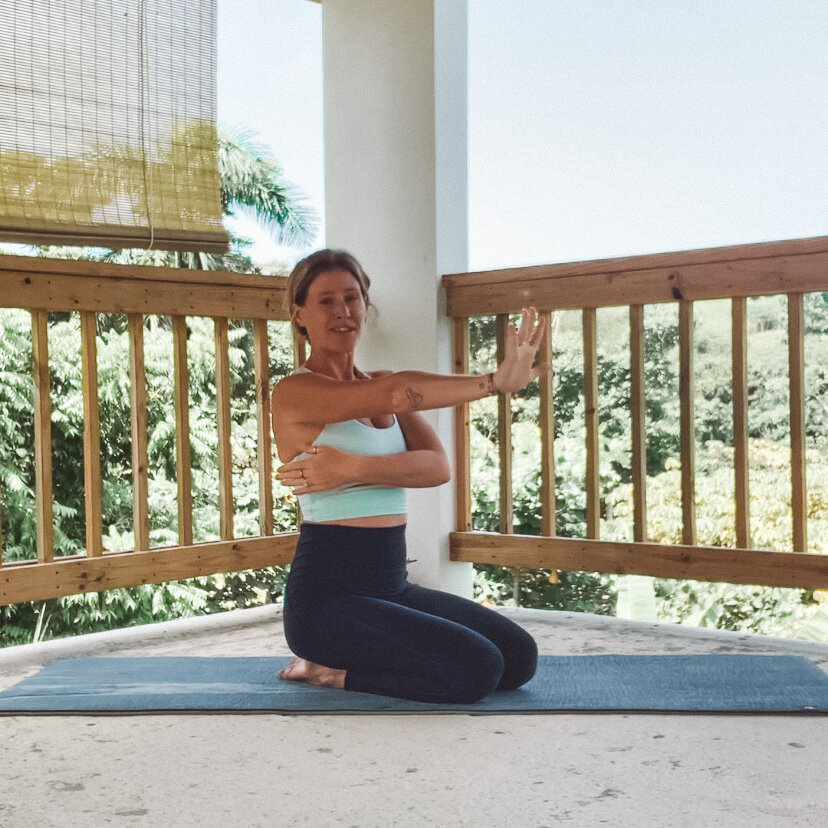In the majority of yoga classes (especially any kind of Vinyasa or Hatha yoga practices), a decent amount of time is typically spent bearing weight on the hands. Table Top, Plank pose, Chaturanga Dandasana, and Downward-facing Dog are just a few examples of these weight-bearing postures that are likely to be cued.
Now, when it comes to spending time on our hands, it’s important to take a look at the support around the shoulder joint. I think it’s common for most of us to associate our shoulders with movement and mobility. After all, we use our hands A LOT to interact with the world around us, so it makes sense that our shoulders need to be able to move relatively easily. Another common ‘misconception’ (and I’m guilty of this, too) is that we tend to associate our shoulders with weakness or fragility. As a surfer, I used to be so worried about ‘over-doing’ any kind of shoulder strengthening work on my mat, thinking that it would somehow lead to an injury since I already used my shoulders so much to paddle. (Side note without going on a tangent: Strength work is not the same as doing a high number of reps… but that’s another topic for another time).
Once I dove into my 500-hour studies with Yoga Medicine, specifically their 55-hour Orthopedic Shoulder Module that I completed last year, I realized that our bodies are not only brilliant but incredibly resilient, and our shoulders are designed to be both mobile AND strong!! In fact, a balance of mobility and stability - paired with mindful movement - is what supports longevity in any joint.
So when we look specifically at the shoulder, there are two moving parts that we need to stabilize: the upper arm bone (the humerus) and the shoulder blade (the scapula). And in order to create deep sense of stability within any joint, it’s essential that we get those deep stabilizing muscles (as my teacher Tiffany calls them, ‘mindfulness muscles’) all around the joint to engage in order to draw the bones into an optimal position so that the more superficial, movement-producing muscles can fire, translating to more efficient (and more likely to be injury-free) movement. Basically, we want everyone to do their jobs in order to create 360* of support.
Through my studies with Yoga Medicine, I’ve picked up these 4 cues to integrate shoulder stability into any weight-bearing posture that you move through. And as I mention in the video, this is not just limited to the poses you practice on your mat but can be applicable to your cross-training and even maybe your sport!
Check out the video as well as a written breakdown below.
4 Cues for Stabilizing the Shoulders When Weight Bearing >>>
Spread your hands into the floor to connect to your foundation (just as you would connect to your feet when standing). Hug the upper arm bone (head of the humerus) down into the socket to engage through the top of the shoulder.
Push the mat away from you as you hug the shoulder blades into the back of the ribs to engage the scapular stabilizers - the rhomboids between the shoulder blades and serratus anterior on the sides of the ribs.
Recruit support through the front of the shoulder and the chest by isometrically (engaging without moving) hugging the hands and forearms in towards each other, like you’re holding a beach ball between your forearms.
Recruit support through the back of the shoulder by finding a subtle external rotation through the upper arm bones (think wrapping your triceps and elbows back) to broaden the collarbones, creating a bit of space through the front of the shoulder - an area where we have a tendency to collapse.
If these cues are super new to you, begin by practicing them seated with your arms out in front of you or standing with your hands at the wall. Then you can incorporate them into Table top, Plank, Downdog, Chaturanga, etc… If it is helpful, begin by exaggerating these cues until you feel them in your body. Then begin to refine them and see if you can make it a little more subtle. The key to tapping into these ‘mindfulness muscles’ is, you guessed it, mindfulness and subtlety. Remember that they aren’t the big movers but are there to help reinforce that deep sense of stability and support.

